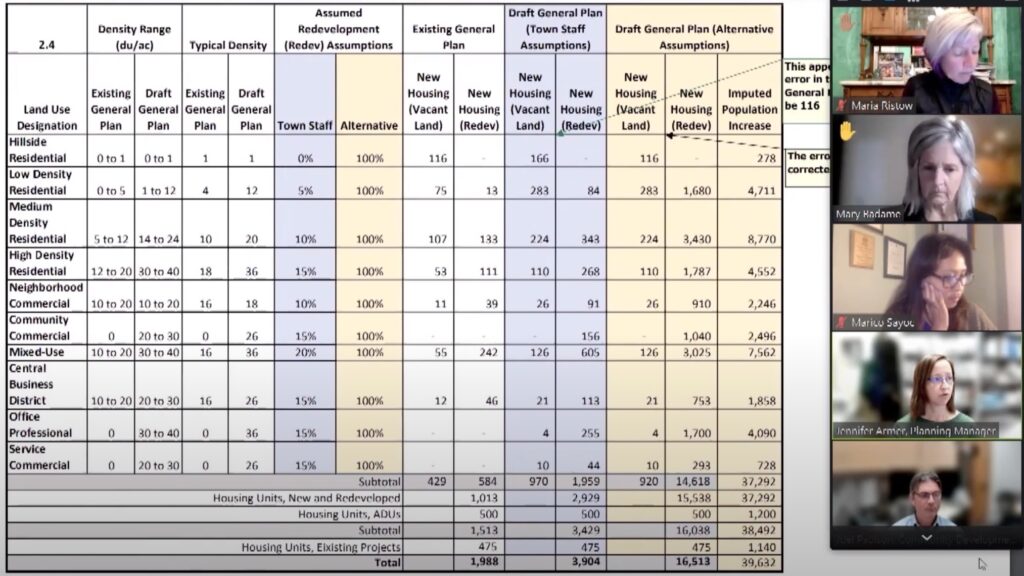As Council members discussed the emerging General Plan and Housing Element documents, during a special session Dec. 7, they appeared hyper-aware they were dealing with one of the most sensitive subjects for many locals.
Officials looked at how the Town might alter its plans now that SB9 has become law, since this changes rules around subdividing certain properties.
Local planners say they’ve been pondering how updated requirements could eliminate the need to rezone existing low-density residential areas, since Sacramento “has already effectively done that for us,” as staff put it in their report.
The General Plan Advisory Committee has already spent two-and-a-half years considering how to formulate the community’s new General Plan, which is to guide the growth of Los Gatos until 2040.
Jennifer Armer, Los Gatos’ planning manager, said the Town has also been looking at how to best plan for the upcoming eight-year Regional Housing Needs Allocation (RHNA) Housing Element cycle.
“The update and review process was conducted with an understanding that the next housing element—an eight-year Housing Element—would likely have to provide room for 2,000 additional housing units,” Armer said. “The staff report provides some additional alternatives, taking this direction from Council members.”
One of those ideas is to keep “low density” and “medium density” regulations at the same density rate as under the last General Plan, making changes elsewhere.
Another alternative would be to remove density from the “office professional” and “service commercial” sections of town, according to Armer.
Los Gatos could also get rid of “community commercial” and just keep “neighborhood commercial,” she said.
“Any of these kinds of options can be presented to Planning Commission and then to Town Council for consideration,” she said. “There are more choices. This is not a done deal. There’s still opportunities to provide comments.”
Councilmember Rob Rennie, who is now mayor, started with a question about a table with two columns, one about “residential capacity,” and one with “potential eligible units” for the Housing Element.
“Why do we have units included in the General Plan that can’t be used for Housing Element?” he asked.
Armer explained that some additional housing can be included in General Plan projections, since that’s expected to be approved before the Housing Element, plus, the two documents have different timescales.
“We include projects that are already approved, including some that are likely to receive building permits before the Housing Element is adopted and certified—and therefore would not count towards the RHNA allocation for this next eight-year cycle,” she said. “We have a set number of accessory dwelling units (ADUs) that we are predicting will be approved annually, and since this is a 20-year plan, only eight-years-worth of those would be included.”
Rennie noted the State expects Los Gatos to plan to house people of different income levels.
“I’m trying to understand, if we happen to have some housing that’s built affordably, or comes up to an affordable number, but if it’s not income restricted, can we count it towards our ‘affordable’—with ADUs being an example of that?”
Joel Paulson, Los Gatos’ community development director, said the Town has been allowed to chalk up all ADUs as affordable, so far, although that could change.
“In our current cycle we actually are allowed to count all of our ADUs as ‘moderate income,’ even though they are not deed-restricted,” he said. “We will be going through a similar effort to see what categories we can apply ADUs to in the next cycle.”

Councilmember Matthew Hudes drew attention to the proposed density increase for single-family-dwelling zones— from 0-5 units to 1-12—and wondered why the Town was moving forward with this if the Housing Element won’t be approved until afterwards.
“It looks to me like ‘cart before the horse,’” he said, drawing attention to the way in which SB9 might cause homeowners to put carriage houses on their properties, resulting in unexpected additional units. “I think that it could be premature to enact the General Plan when it doesn’t analyze the impact of a law that’s already in effect in January 1st, 2022.”
Paulson said Council members will have ample time to get guidance from the State about these issues before they vote on the General Plan.
“There is a lot of background work that needs to be done, a lot of conversation about site selection,” he said. “Whether it’s the existing General Plan numbers, or we get to the point where we have an adopted General Plan—those numbers can be changed and we can reanalyze that.”
It was Councilmember Mary Badame who brought forward what is apparently the biggest lightning rod of growth discussions, digging into just how planners came up with the almost 3,000 housing units Los Gatos officials are currently looking at allowing.
“Where did the assumption of 2,929 housing units come from?” Badame asked. “What basis do we have for that assumption?”
Armer said the calculation is based on expected housing units that would come via redevelopment of existing parcels, assuming “typical” density would apply and factoring in the percentage of owners who would choose to build on their property. The original document had a typo, and “hillside residential” would have just 116—not 166.
But Badame was not nitpicking. She was focused on the trendlines for overall growth.
“So, if this is an assumption, it could be wrong,” she said. “It could even be higher than that. Am I correct?”
Armer said the Town’s used figures provided by consultants—including an economic development subconsultant—and was developed based on growth projections and density updates.
“We actually have a letter from the Los Gatos Community Alliance, and they’re reporting potential for development of 74,007 units,” Badame replied.
Armer said that figure assumes every parcel would redevelop to the maximum extent, and that the Town doesn’t believe that will happen.
Then-mayor Marico Sayoc noted there were 42 attendees mid-meeting, and according to YouTube’s public view count, just 24 people had streamed it there, by Dec. 20.
Councilmember Maria Ristow, who is now vice mayor, thanked staff for putting together the presentation, and noted she was on the General Plan Advisory Committee with Badame.
“It was interesting to watch how the process unfolded—going in knowing that we had a huge amount of housing to prepare for based on the fact that pretty much none of the cities in Silicon Valley have built to keep up with where we need to be,” she said, reflecting on the State housing-build requirements. “We finally all got these huge numbers and we had to suddenly think about a very different way to build, as opposed to, ‘Oh there’s a vacant lot here, a vacant lot there.’”
To Ristow, the question is: how do you redevelop a mostly-built-out town?
“There wasn’t a specific number that the GPAC was working toward,” she said. “It was more of a process of, ‘Here’s a location that makes sense to add density (to); here’s a location where we could build more housing.’ And as we worked through the process…this is where we came out.”
The public review period on the draft Environmental Impact Report closes at 5pm on Friday, Jan. 7.
The Planning Commission is expected to take up the Draft 2040 General Plan early next year.
Staff hopes to bring the 2040 General Plan to Council in April.









